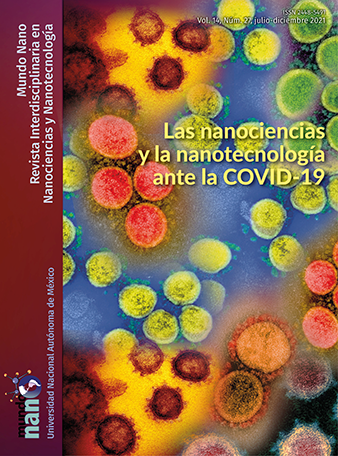Biocompatibilidad y actividad microbiana de sulfuro de plata nanoestructurado para aplicación en biomateriales: revisión sistemática
Contenido principal del artículo
Resumen
Actualmente nos enfrentamos a un panorama díficil por la marcada resistencia antibiotica a los agentes antimicrobianos existentes. Las infecciones microbianas representan una importante amenaza clínica por lo que es necesario buscar alternativas de nuevos agentes, realizando pruebas de sensibilidad microbiana y de biocompatibilidad. El objetivo de esta revisión es realizar una búsqueda sistemática sobre la actividad microbiana y la biocompatibilidad de nanoestructuras de sulfuro de plata, para aplicaciones en los biomateriales. La búsqueda se realizó en las bases de datos ScienceDirect, Web of science y PubMed en octubre de 2020, utilizando las palabras clave: biocompatibilidad, viabilidad celular, actividad antimicrobiana o efecto antifúngico. Se siguieron los lineamientos del PRISMA para las revisiones sistemáticas. Los trece artículos incluidos de estudios in vitro o in vivo mostraron que las nanoestructuras de sulfuro de plata inhiben microrganismos Gram(+) y Gram (-) como S. aureus y E. coli, respectivamente, sin importar el tamaño. Puntos cuánticos menores a 5 nm de sulfuro de plata presentan más del 65% de viabilidad celular con fibroblastos o células humanas. Se concluye que la actividad antimicrobiana y viabilidad celular que presentan las nanoestructuras de sulfuro de plata no mostraron una dependencia con el tamaño y la concentración, pero podrían utilizarse en biomateriales.
Descargas
Detalles del artículo

Mundo Nano. Revista Interdisciplinaria en Nanociencias y Nanotecnología, editada por la Universidad Nacional Autónoma de México, se distribuye bajo una Licencia Creative Commons Atribución-NoComercial 4.0 Internacional.
Basada en una obra en http://www.mundonano.unam.mx.
Citas
Aydemir, Duygu., Hashemkhani, Mahshid., Acar, Havva, Yagic y Ulusu, Nuriye, Nuriye. (2020). Evaluation of the biocompatibility of the GSH- coated Ag2S quantum dots in vitro: a perfect example for the non-toxic optical probes. Molecular Biology Reports, 47: 4117-4129. https://doi.org/10.1007/s11033-020-05522-3 DOI: https://doi.org/10.1007/s11033-020-05522-3
Ayoghya, Dasari y Veerabhadram, Guttena. (2016). Green synthesis, characterization, photocatalytic, fluorescence and antimicrobial activities of Cochlospermum gossypium capped Ag2S nanoparticles. Journal of Photochemistry & Photobiology, B: Biology, 157: 57-69. https://doi.org/10.1016/j.jphotobiol.2016.02.002 DOI: https://doi.org/10.1016/j.jphotobiol.2016.02.002
Delgado-Beleño, Y., Martinez-Nuñez, C. E., Cortez-Valadez, M. y Flores-Lopez, N. S. (2018). Optical properties of silver, silver sulfide and silver selenide nanoparticles and antibacterial applications. Materials Research Bulletin, 99: 385-392.https://doi.org/10.1016/j.materresbull.2017.11.015 DOI: https://doi.org/10.1016/j.materresbull.2017.11.015
Feng Lu, Yi Gong, Wenwen Ju, Feng Cheng, Kaiwei Zhang, Qi Wang, Wenjun Wang, Junbo Zhong, Quli Fan, y Wei Huang. (2019). Facile one-pot synthesis of monodispersed NIR-II emissive silver sulfide quantum dots. Inorganic Chemistry Communications, 106: 233-239. https://doi.org/10.1016/j.inoche.2019.06.013 DOI: https://doi.org/10.1016/j.inoche.2019.06.013
Jafari, Leila., Pourahman, Afshin y Asadpour, Leila. (2017). Rice husk based MCM-41 nanoparticles loaded with Ag2S nanostructures by a green and room temperature method and its antimicrobial property. Inorganic and Nano-Metal Chesmistry, 47(11): 1552-1559. https://doi.org/10.1080/24701556.2017.1357609 DOI: https://doi.org/10.1080/24701556.2017.1357609
Javidi, Javidi., Haeri, Azadeh., Shirazi, Farshad, Hosseini., Kobarfard, Farzad y Dadashzadeh, S. (2017). Synthesis, characterization, in vivo imaging, hemolysis, and toxicity of hydrophilic Ag2S near-infrared quantum dots. Journal of Cluster Science, 28(1): 165-178. https://doi.org/10.1007/s10876-016-1060-5 DOI: https://doi.org/10.1007/s10876-016-1060-5
Huo, Pengwei., Liu, Chongyang., Wu, Dongyao., Guan, Jingru., Li, Jinze., Wang, Huiqin y Yuan, Shouqui. (2018). Fabricated Ag/Ag2S/reduced graphene oxide composite photocatalysts for enhancing visible light photocatalytic and antibacterial activity. Journal of industrial and engineering chemistry, 57: 125-133. https://doi.org/10.1016/j.jiec.2017.08.015 DOI: https://doi.org/10.1016/j.jiec.2017.08.015
Ibrahim Khaleelullah, M. M. S., Dheivasigamani, T., Natarajan, P., Masuda, Y., Inami, W., Kawata, Y., y Hayakawa, Y. (2016). Size controlled synthesis of silver sulfide nanostructures by multi-solvent thermal decomposition method. Journal of Crystal Growth, 468: 119-124. https://doi.org/10.1016/j.jcrysgro.2016.10.081
Iqbal, Tahir., Ali, Faisal., Khalid, N.R., Tahir, M. Bilal y Ijaz, Mohsin. (2019). Facile synthesis and antimicrobial activity of CdS-Ag2S nanocomposites. Bioorganic Chemistry, 90: 103064. https://doi.org/10.1016/j.bioorg.2019.103064 DOI: https://doi.org/10.1016/j.bioorg.2019.103064
Mohamed Mathar Sahib Ibrahim Khaleelullah, Thangaraju Dheivasigamani, Prakash Natarajan, Yuriko Masuda, Wataru Inami, Yoshimasa Kawata, Yasuhiro Hayakawa. (2017). Size controlled synthesis of silver sulfide nanostructures by multi-solvent thermal decomposition method. Journal of Crystal Growth, 468: 119-124. https://doi.org/10.1016/j.jcrysgro.2016.10.081 DOI: https://doi.org/10.1016/j.jcrysgro.2016.10.081
Subramaniyan, Siva, Bola., Megarajan, Segan., Vijayakumar, Santhash., Mariappan, Mariappan y Anbazhagan, Veerappan. (2018). Evaluation of the toxicities of silver and silver sulfide nanoparticles against Gram-positive and Gram-negative bacteria. IET nanobiotechnology, 13(3): 326-331. https://doi.org/10.1049/iet-nbt.2018.5221 DOI: https://doi.org/10.1049/iet-nbt.2018.5221
Sadovnikov, S. I., Rempel, A. A., y Gusev, A. I. (2018). Nanostructured silver sulfide Ag2S nanostructured lead, cadmium, and silver sulfides. En Nanostructured lead, cadmium, and silver sulfides. Suiza: Springer International Publishing. https://doi.org/10.1007/978-3-319-56387-9 DOI: https://doi.org/10.1007/978-3-319-56387-9
Vardar Deniz Özkan, Aydin Sevtap, Hocaoğlu İbrahim, Acar Havva Yağci y Basarán Nursen. (2018). Effects of silver sulfide quantum dots coated with 2-mercaptopropionic acid on genotoxic and apoptotic pathways in vitro. Chemico-biological interactions, 291: 212-219. https://doi.org/10.1016/j.cbi.2018.06.032 DOI: https://doi.org/10.1016/j.cbi.2018.06.032
Vardar Deniz Özkan, Aydin Sevtap, Hocaoğlu İbrahim, Acar Havva Yağci y Basarán Nursen. (2019). An in vitro study on the cytotoxicity and genotoxicity of silver sulfide quantum dots coated with Meso-2, 3-dimercaptosuccinic Acid. Turkish Journal of Pharmaceutical Sciences, 16(3): 282-291. https://doi.org/10.4274/tjps.galenos.2018.85619 DOI: https://doi.org/10.4274/tjps.galenos.2018.85619
Xiong, Ke., Li, Jun., Tan, Lei., Cui, Zhenduo., Li, Zhaoyang., Wu, Shuilin y Liu, Xiangmei. (2019). Ag2S decorated nanocubes with enhanced near-infrared photothermal and photodynamic properties for rapid sterilization. Colloid and Interface Science Communications, 33: 100201. https://doi.org/10.1016/j.colcom.2019.100201 DOI: https://doi.org/10.1016/j.colcom.2019.100201
Wiercigroch-Walkosz, Katarzyna., Cichos, Jakub., Wysokińska, Edyta., Rotko, Grzegorz., Kałas, Wojciech y Karbowiak, Miroslaw. (2019). Near-infrared Ag2S quantum dots loaded in phospholipid nanostructures: physical properties, stability and cytotoxicity. Colloids and Surfaces A: Physicochemical and Engineering Aspects, 579: 123631. https://doi.org/10.1016/j.colsurfa.2019.123631 DOI: https://doi.org/10.1016/j.colsurfa.2019.123631
Zhong, Yaping., Zou, Yibiao., Liu, Lingyan., Li, Ruohan., Xue, Fengefeng y Yi, Tao. (2020). pH-responsive Ag2S nanodots loaded with heat shock protein 70 inhibitor for photoacoustic imaging-guided photothermal cancer therapy.” Acta Biomaterialia. 115 (2020): 358-370. https://doi.org/10.1016/j.actbio.2020.08.007 DOI: https://doi.org/10.1016/j.actbio.2020.08.007





